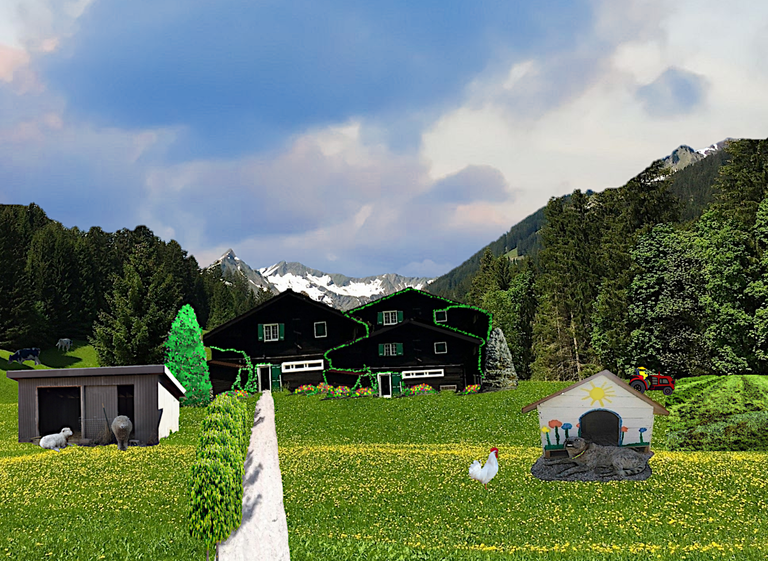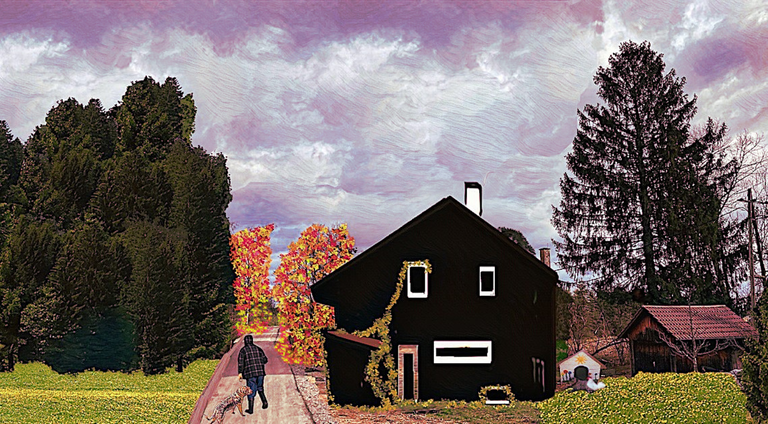

I loved @shaka' template picture this week. You can see by the number of renditions I made that I got caught up in the scene. Here is @shaka's photo:

I zeroed in on the house right away. After that I spent time imagining a landscape. The first image I finished was the GIF at the top of the blog. Last night I started on a new format, which you can see in the second picture. I wanted to feature that amazing dog and doghouse more specifically. The dog belongs to an LMAC colleague, @muelli and the picture was borrowed from LIL, LMAC's image library. More about LIL later.
Here are a couple of more collage renditions:



As I worked on the house in the picture, changing its shape and size, one thing seemed to be missing: a front porch. When I think of a country house, especially a farm house, I always imagine a front porch. I wondered, is the front porch an architectural custom peculiar to the U. S.? I looked up the history of this feature (I will look up anything) and sure enough, this amenity is closely associated with the U. S. A.

Image credit: NRA (US government). Public domain
In this brief discussion I depend entirely on resources I consulted. First of all, it became clear to me that it's not just a porch that is traditional. It is a front porch. According to an article I found on a University of Virginia website, porches first appeared in the U. S. in the early eighteenth century. The author of the article states, "One century later, porches had become an integral element of American architecture."
Washington Irving Porch, Sunnyside, NY (c. 1835)

Image credit: Adrianne Wadewitz. Used under CC 3.0 license.
Why did porches become so popular? The Virginia U. article traces the use to a number of factors. Slaves were transported from West Africa, where front porches were traditionally placed on the front of shotgun houses. The article asserts, "...the shotgun house, built by the African slave, appeared as one of the first American houses to universally exhibit a front porch". The same assertion is made in another online publication, American Profile.
Mary Cecil Cantrill, Georgetown, Scott County, KY

Image credit: National Park Service. (Building construction 1901) Public domain.
According to American Profile, by the 1880s just about every house in the U.S., no matter how humble or grand, had a front porch. As a matter of fact, in 1880 presidential candidate James A. Garfield conducted a 'Front Porch Campaign'. Thousands of people traveled to Garfield's house to hear him deliver policy statements from his front porch. The U.S. National Park Service website states, "From the porch serving as his podium, Garfield discussed 'The Possibilities of Life,' 'The Immortality of Ideas,' and 'German Citizens'."
President James A. Garfield's House, and Front Porch

Image credit: Unknown author (1914). Public domain.
A front porch, according to a publication fittingly called FrontPorchRepublic, was more than a decorative addition to the house. It had social function. The front porch “presented opportunities for social intercourse at several levels.” It was a bridge between private life and public life.
American Profile explains that the front porch lost much of its popularity after WWII. The website attributes this decline to a number of factors: "automobiles, air-conditioning, television and, most of all, suburbs". With the decline of the front porch there was a commensurate rise in the use of backyard patios.
Backyard Deck, 2006 Note the Fences)

Image credit: en:user:Jdoorjam. Used under CC 2.5 license
The FrontPorchRepublic explains that "the patio reflected...the increasing desire for privacy and withdrawal from interaction with one’s neighbors."
As I started this discussion of the front porch, I was clear that the ideas expressed in this essay are not mine. I defer to people who understand the history of this structure. However, I have quoted ideas I find convincing, at least on the surface. If not convincing, than at least interesting. I hope my readers also find the ideas interesting.
I could not have completed my collages without the help of my colleagues in LMAC who contributed images to LIL, our image gallery.
The person walking on the lane in a couple of the pictures was contributed by @reheadpei.
@redheadpei also contributed the rooster that appears in all the pictures.
@mballesteros contributed the trees that line the lane in several of the pictures.
Then, of course, there is the amazing dog and dog house from @muelli.
The path also came from @muelli.
Finally, several of the collages used elements from an earlier template
by @shaka

Each of these #LIL contributors will be designated 2% beneficiary on this post.
In addition to the elements already mentioned, I used several of my own contributions to LIL, including the cows, sheep/shelter, large evergreens, small bushes, tractor, dog and crop field.
In making the collages I did a lot of digital painting (mostly flowers and leaves, though other accents where needed). I used Paint, GIMP, and Paint3D to manipulate the frames. Several of the collages also benefited from a Lunapic filter.
LIL and LMAC
LMAC is the wonderful collage contest started by @shaka a couple of years ago. Every week bloggers on Hive come together and offer their interpretation of a template photo published by @shaka. Some of the participants are professional artists. Many are not. I am not. And yet, when we make our collages we do become artists for at least a while. There are handsome prizes. I don't compete for these. I just have fun.
Rules and regulations for the contest may be found here, on @shaka's blog.
LIL is an extension of LMAC. The image library is available to everyone in the Hive community. Anyone can borrow an image from our library, which has in excess of 6,000 pictures now. Anyone on Hive can contribute to the library. Contributions are not only welcome, but are supported by the community if rules and procedures are followed. These may be found here.
Thank You
I thank @shaka for leading the LMAC community. I thank @quantumg for his amazing coding skills and hard work. I thank @mballesteros for her hard work and creativity on our LMAC team. And, I thank everyone who participates in the community. People and participation are the essence of LMAC.



